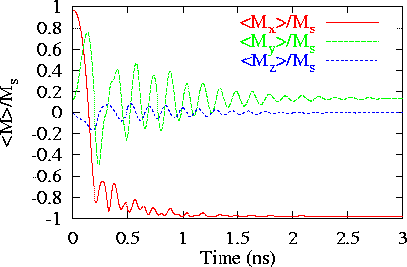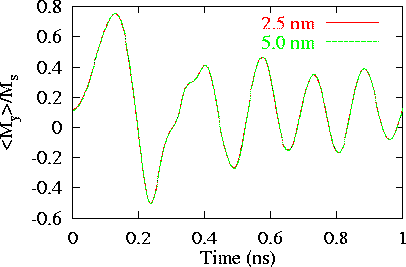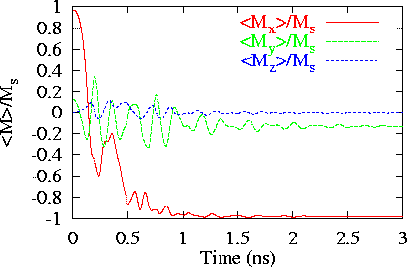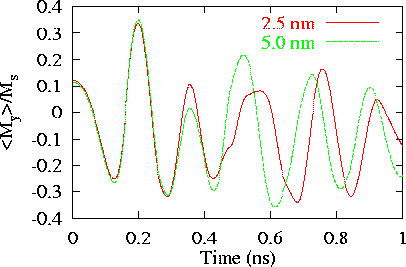µMAG Standard Problem #4 results
See the problem specification.
Disclaimer
µMAG could not succeed without the contributions
of colleagues working outside NIST. Although we value the
contributions made by these colleagues, NIST does not necessarily
endorse the views expressed or the data presented in the submitted
solutions shown below.
Solution directory
- Comparisons
- G. Albuquerque,
J. Miltat and A. Thiaville
-
R. D. McMichael, M. J. Donahue, D. G. Porter, and
J. Eicke
-
Liliana Buda, Lucian Prejbeanu, Ursula Ebels and Kamel
Ounadjela
-
E. Martinez, L. Torres and L. Lopez-Diaz
-
José L. Martins and Tania Rocha
-
P.E. Roy and P. Svedlindh
-
Massimiliano d’Aquino, Claudio Serpico,
and Giovanni Miano
-
Dmitri Berkov
-
M. J. Donahue and D. G. Porter
-
Rasmus Bjørk, E. B. Poulsen and A. R. Insinga
Submitted Solution:
E. Martinez, L. Torres and L. Lopez-Diaz
- Date:
- December 12, 2000.
- From:
- E. Martinez, L. Torres and L. Lopez-Diaz
Departamento de Fisica Aplicada, Universidad de Salamanca,
Plaza de la Merced s/n 37008, Spain
- Contact:
- Luis Torres
Our group at Salamanca, Spain, has performed simulations on the µMAG
standard problem #4. The results are very close to those recently
submitted by Albuquerque and McMichael groups.
A finite difference scheme in 2D (one cell across the thickness of
the sample) with 3D spins was used. The exchange energy is computed by
the four-neighbor dot product representation. The demagnetizing field
is calculated by fast Fourier transform techniques using zero padding,
and magnetostatic energy was computed under assumption that the
magnetization was uniform within each cell and it is allowed to rotate
in 3D. The demagnetizing tensor is calculated using Newell's
expressions (average over the volume of each cell) particularized to
2D. Three sizes for the cell were tested: 5 nm, 3.125 nm, and 2.5 nm
cells. Our code was previously used successfully to resolve the µMAG standard problem #2
[J. Appl. Phys. 85 (8), 5813, (1999)].
The Landau-Lifshitz equation was resolved using the Euler's method
with different time steps in the range 3-15 fs (femtoseconds). A time
step of 3.14 fs was used to calculate the results shown below. In the
case of 2.5 nm cells, because of the simple Euler's method utilised,
time steps less than 5nm were necessary for obtaining an adequate
convergence of the solution. Larger time steps produced oscillating
solutions.
Results:
Field 1

The temporal
evolution of the magnetization components spatially averaged over the
sample is represented using 2.5 nm cell size and time step of 3.14 fs
for the field applied 170° from the x-axis.

Comparison of My vs. t data
calculated with 2.5 nm cells and 5 nm cells. In this case, the results
are insensitive to the mesh (No difference is appreciated in the
figure).

An
image of the magnetization when Mx first crosses
zero.
Field 2

M
vs. t for the second part of the problem, with the field
applied 190° from the x-axis (Field 2), with 2.5 nm
cell size and time step of 3.14 fs.

Comparison of My vs. t data
calculated with 2.5 nm cells and 5 nm cells. These results show
dependence on the mesh size. The differences increase with time.

Finally, an image of the magnetization when Mx
first crosses zero.
Raw Data:
Time series data contain 4 columns: time (ns),
Mx/Ms,
My/Ms,
Mz/Ms,
and vector data is in
omf format.
Please send comments to [email protected] and join the
µMAG discussion e-mail list.
Site Directory
µMAG organization / NIST CTCMS /
[email protected]
11-NOV-2021





